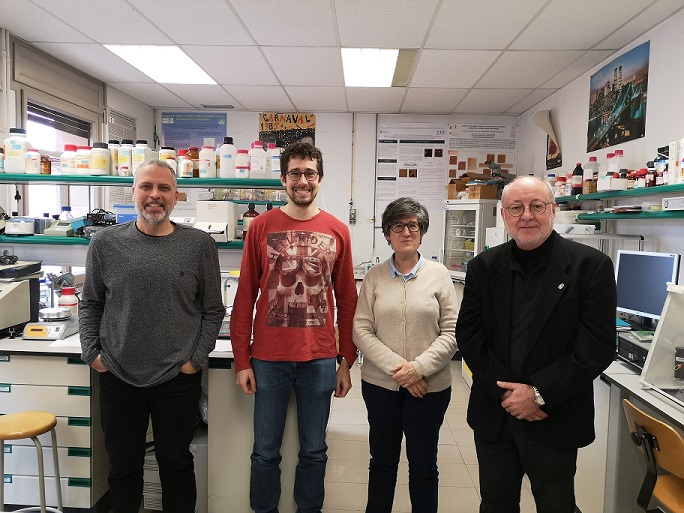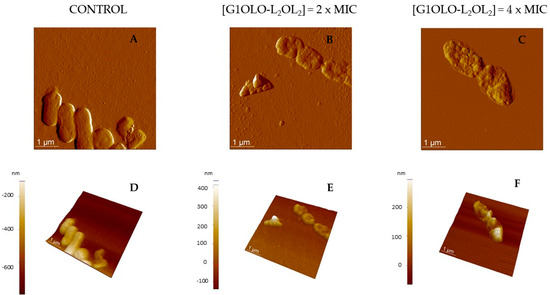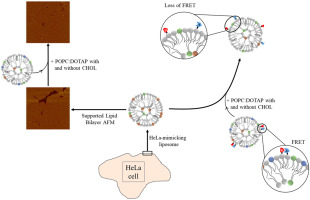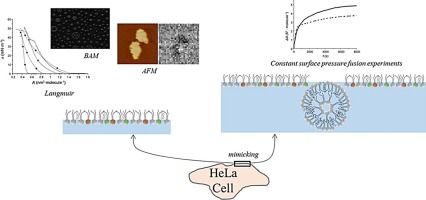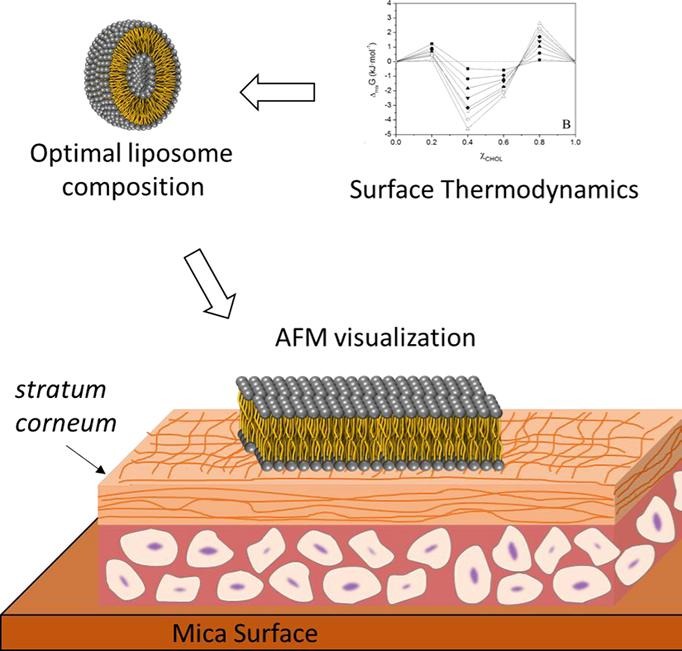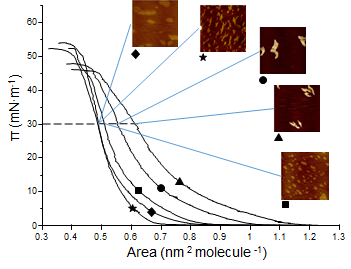Biophysics of Biomembranes
The Nanostructures of Biomembranes Group has traditionally worked with spectroscopic techniques, particularly spectrofluorimetry, NMR, DSC, Langmuir monolayers and Langmuir Blodgett films and more recently, with the Atomic Force Microscope (AFM).
What characterizes the group is the fact that we combine the application of these techniques with molecular biology methods for which we are self-sufficient. Specifically, we obtain the proteins under investigation, lactose permease, NorA or KcsA, from Escherichia coli cultures. These proteins are models of efflux pump proteins related with the drug resistance in bacteria. We can extract the proteins from the cell membrane and after purification, we finally reconstitute them into membrane models of desired compositions. Spectrofluorometric studies of surface potential or FRET tell us about the interactions between proteins and the lipids that surround it. The characterization of the membrane models with the AFM allows the visualization and interaction (Force Spectroscopy) with an individual molecule of protein giving us the idea of the necessary force to take it out of the membrane. This information is important to understand how proteins are inserted in cell membranes and how they perform their function. Altering the membrane lipid composition modifies these force profiles suggesting a possible approach to inhibit the functionality of the protein when inserted in the membrane.
Members
Dr. Jordi Borrell Hernandez (Catedràtic) [Scopus] [Scopus] [ORCID]
Dra. María Teresa Montero Barrientos (Titular) [Scopus] [ORCID]
Dr. Òscar Domènech Cabrera (Agregat) [Scopus] [ORCID]
Dr. Adrià Botet Carreras (Associat) [Scopus] [ORCID]
Relevant projects
Nanobioenginyeria i Nanobioelectrònica, SIC-BIO.SGRC- Ajuts de Suport als Grups de Recerca de Catalunya (SGR) 2017SGR1079. 2018-2021 IP. Josep Samitier Martí
Microscopio de barrido de fuerzas eléctricas para medidas electrofisiológicas a la nanoescala. IP. Gabriel Gomila. TEC2016-79156-P. Ministerio de Economía y Competitividad (MCOC), 2016-2019
Breaking the Borders of Antimicrobial Resistance. Searching New Antimicrobial Compounds against Multi-Drug Resistant Bacteria: A Study of Policationic AMPS and Lipid Nanoparticles. Fundació La Marató (TV3) (FMTV). 2018-2021. IP. Miquel Viñas Ciordia
Singular cientific equipment
Multimode IV Atomic Force Microscope from Bruker controlled by Nanoscope V electronics equipped with a 15 μm scanner.
Two KSV Nima Langmuir troughs equipped with surface pressure balance, surface potential and Brewster Angle Microscope (BAM).
SLM Aminco 8100 Spectrofluorometer equipped with Xenon Lamp and thermostatted cuvette holder.
Internationals collaborations
Ronald H. Kaback. Department of Physiology. University of California, Los Angeles, USA. Physicochemical studies of Lactose permease (Lac Y) protein in model membranes.
Pierre Emmanuel Milhiet. Structural Biochemistry Centre CNRS UMR 5048 – UM – INSERM U 1054, Montpellier, France. Physicochemical studies of Macromolecules – model membrane interactions by AFM.
Marie-Paule Mingeot Leclercq. Department of Cellular and Molecular Pharmacology, Catholic University of Louvain, Brussels, Belgium. Macromolecules – model membrane interactions.
Manuel Prieto. Molecular Physical Chemistry Centre, Technical University of Lisbon, Portugal. FRET fluorescence studies between membrane proteins and lipids in the annular region.
New nanotransporter for drug delivery inside cells
A new study by the University of Barcelona has analized the viability of a new nanomolecule as drug delivery vehicle. The results, published in the journal Colloids and Surfaces B:…
Studying Lipid Membrane Interactions of a Super-Cationic Peptide in Model Membranes and Living Bacteria.
The super-cationic peptide dendrimers (SCPD) family is a valuable class of antimicrobial peptide candidates for the future development of antibacterial agents against multidrug-resistant gram-negative bacteria. The deep knowledge of their…
Engineering and development of model lipid membranes mimicking the HeLa cell membrane.
Cells are complex systems whose interaction with nanocarriers, i.e., liposomes, are continuously under investigation to improve drug uptake. Model membranes can facilitate the understanding of the processes involved in fusion…
Characterization of monolayers and liposomes that mimic lipid composition of HeLa cells.
In this work, based on several studies, we develop an artificial lipid membrane to mimic the HeLa cell membrane using 1-palmitoyl-2-oleoyl-sn-glycero-3-phosphatidylcholine (POPC), 1-palmitoyl-2-oleoyl-sn-glycero-3-phosphoethanolamine (POPE), 1-palmitoyl-2-oleoyl-sn-glycero-3-phospho-l-serine (POPS) and cholesterol (CHOL). This…
Planar lipid bilayers formed from thermodynamically-optimized liposomes as new featured carriers for drug delivery systems through human skin.
The fundamental objective pursued in this work is to investigate how liposomes formed with a thermo- dynamically optimized molar composition formed by the main components of the stratum corneum matrix…
Effect of cholesterol on monolayer structure of different acyl chained phospholipids
In this work we have investigated the effect of cholesterol (CHOL) in phospholipid monolayers on a series of phosphatidylcholines differing in acyl chain composition. We have used the CHOL proportion…


